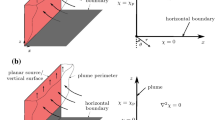Abstract
Some years ago we developed a theoretical model for the calculation of the rise of a stack plume in the atmosphere. Recently we have extended this model in such a way that the ground level concentration of gases emitted by a stack can also be calculated. The cross-section of the plume, which was originally assumed to be a circle, is now assumed to be an ellipse. The height-to-width ratio of the ellipse is chosen in accordance with full-scale data. The entrainment of air into the plume due to atmospheric turbulence can now be calculated not only for neutral atmospheric conditions, but also for stable and unstable conditions.
Predictions of the ground level concentration made with this model have been compared with predictions made with the often used virtual point source model. For neutral and unstable atmospheric conditions the agreement is rather good. For stable conditions the differences can be rather large. The sensitivity of the ground level concentration with respect to the atmospheric stability condition, the stack height, the plume exit momentum flux and the plume exit buoyancy flux has also been investigated with the aid of the model. The influence of the plume exit momentum flux is negligible; however, the influence of the other parameters can be large.
Similar content being viewed by others
References
Ooms G (1972) A new method for the calculation of the plume path of gases emitted by a stack. Atmos Envir 6: 899.
Ooms G, Mahieu AP and Zelis F (1974) The plume path of vent gases heavier than air. Paper presented at the First International Symposium on Loss Prevention and Safety Promotion in the Process Industries, The Hague, The Netherlands.
Briggs GA (1971) Some recent analyses of plume rise observation. Proceedings of the Second International Clean Air Congress. New York: Academic Press.
Singer IA and Smith ME (1966) Atmospheric dispersion at Brookhaven National Laboratory. Int J Air Water Pollut 10: 125.
Keffer JF and Baines WD (1963) The round turbulent jet in a cross-wind. J Fluid Mech 15: 481
Abraham G (1970) Round buoyant jet in cross-flow. Paper presented at the 5th International Conf. Water Pollution Res., San Francisco, USA.
Albertson ML, Dai YB, Jensen RA and Rouse H (1950) Diffusion of submerged jets. Trans ASCE 115: 639.
Abraham G (1963) Jet diffusion in stagnant ambient fluid. Delft Hydraulics Laboratory Publication No. 29, Hydraulics Laboratory, Delft, The Netherlands.
Richards JM (1963) Experiments on the motion of isolated cylindrical thermals through unstratified surroundings. Int J Air Wat Pollut 7: 17.
Briggs GA (1969) Plume rise. AEC Critical Review Series, USAEC Division of Technical Information Extension, Oak Ridge, Tennessee, USA.
Loh-Nien Fan (1967) Turbulent buoyant jets into stratified or flowing ambient fluids. California Institute of Technology Report No. KH-R-15, California Institute of Technology, Pasadena, California, USA.
Kaimal JC, Wyngaard JC, Haugen DA, Coté OR and Izumi Y (1976) Turbulence structure in the convective boundary layer. J Atmos Sci 33: 2152.
Brummage KG and Blokker PC (1968) The calculation of atmospheric dispersion from a stack. Atmos Envir 2: 197.
Weil JC (1979) Applicability of stability classification schemes and associated parameters to dispersion of tall stack plumes in Maryland. Atmos Envir 13: 819.
Author information
Authors and Affiliations
Rights and permissions
About this article
Cite this article
Ooms, G., Mahieu, A.P. A comparison between a plume path model and a virtual point source model for a stack plume. Applied Scientific Research 36, 339–356 (1981). https://doi.org/10.1007/BF00411893
Accepted:
Issue Date:
DOI: https://doi.org/10.1007/BF00411893




